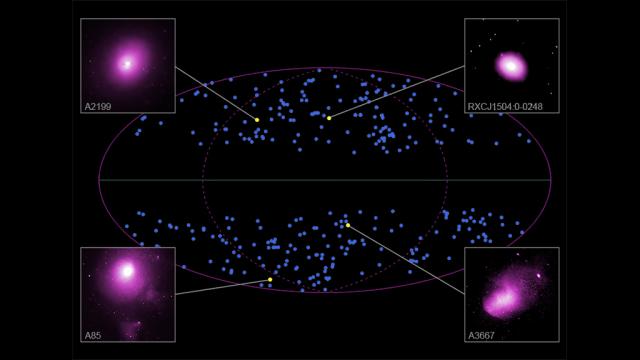Is the universe’s expansion the same everywhere? New research suggests it’s not—which could have huge implications for our understanding of the cosmos.
Scientists led by Konstantinos Migkas at the University of Bonn in Germany analysed data on x-rays released by hundreds of clusters of galaxies, revealing that the universe seems to be expanding differently in different parts of the sky. These results seem to verify other past results, which had previously seemed more like anomalies. And though it’s not yet time to overthrow modern cosmology, scientists are already wondering whether a paradigm shift is on the horizon.
“It’s a very exciting result, with great potential for future work,” Migkas told Gizmodo in an email. “It may lead to rethinking cosmology. But before we do that, we have to make sure we eliminate all the other possible explanations.”
A cornerstone of modern theories to explain the universe is that it’s isotropic, or uniform in all directions, on the largest scales. This means that, barring any more specific interactions between objects, no matter where you are, innate physical properties such as the rate of the universe’s expansion are the same everywhere.
Given how important this assumption is to modern cosmology, scientists have tried to to test it in various ways. For example, the temperature of the most distant radiation astronomers can see is shockingly uniform, though there does seem to be some slight unevenness, called anisotropies. Observations of a type of supernova used as a standard distance calibrator have revealed both a uniform universe and a slightly un-uniform universe, which seems to depend on which supernovae are included in the sample. Scientists have taken plenty of other observations using various probes, looking at visible light and infrared radiation from distant galaxies, gamma ray bursts, or distant radio sources, again with varying results.
The team of scientists in this case compared the brightness and the temperature of the x-rays emitted by different galaxy clusters across the sky. These values, as well as the redshift, or how much the radiation’s colour has been shifted by the universe’s expansion rate, are measurable without relying on assumptions about the universe’s properties. They can measure these properties across the sky, then calculate what properties the universe would need to have in order to produce the results we see with our telescopes. The research is published this month in the journal Astronomy and Astrophysics.
Data for the study came from various x-ray telescopes, including ROSAT, XMM-Newton, and the Chandra X-ray Telescope, which observed 313 galaxy clusters spread across the sky. When they ran their analysis, they found that the universe’s expansion slightly differed in different points of the sky. As a simplification, imagine placing the galaxies on an expanding clockface, where 12:00 and 6:00 are moving outward faster than expected while 3:00 and 9:00 are moving slower than expected. And though the differences from an isotropic (aka uniform) universe weren’t so large if you looked at each individual point, the overall picture was far less likely to have been due to chance alone.
Migkas told Gizmodo that the team isn’t ready to declare the universe’s expansion anisotropic just yet. Perhaps undetected gas and dust clouds absorbed some of the x-rays, making some of the clusters look fainter than they should otherwise. Perhaps some of the galaxy clusters are moving together for reasons unrelated to the universe’s expansion. The team plans to improve their methods, such as by performing the measurements in other wavelengths of light than those used for this study, Migkas said.
One researcher who was not involved in the study, professor Subir Sarkar from the University of Oxford, explained to Gizmodo that the results on their own are an interesting deviation from expectations but are more compelling when combined with results analysing distant radio-emitting galaxies, nearby infrared galaxies, and distant supernovae. Looking at all that data together, it appears that the universe really might be anisotropic. However, he cautioned that this kind of result could be sensitive to changes in statistical analysis in the data or in which galaxy clusters are observed.
Meanwhile, deputy associate director of the High Energy Astrophysics Division of the Harvard-Smithsonian Centre for Astrophysics Alexey Vikhlinin tweeted that he was “willing to bet” that the paper is “junk science.” He told Gizmodo in an email that selecting cosmic objects based on luminosity, as was done in this sample, introduces a well-known kind of bias where the sample is brighter than the overall population. He said that the paper did not properly correct for this bias and may have fallen victim to other selection biases as well.
So, is the universe expanding evenly or unevenly? For now, an isotropic universe is an assumption, and astronomers are still working to prove or disprove that assumption. If the universe really were anisotropic, some of the core theories governing it might require revision. But as is typically the case, it’s going to take more observations before we know the answer for sure.
